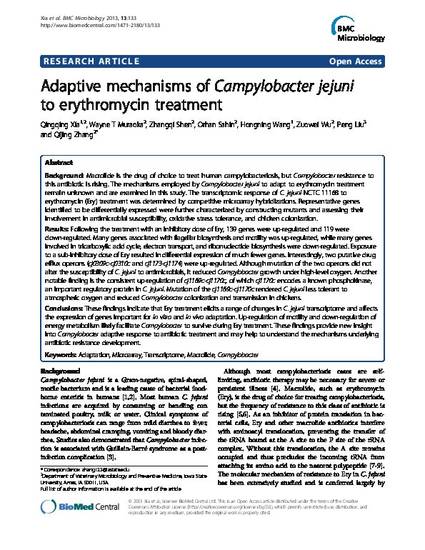
Background
Macrolide is the drug of choice to treat human campylobacteriosis, but Campylobacter resistance to this antibiotic is rising. The mechanisms employed by Campylobacter jejuni to adapt to erythromycin treatment remain unknown and are examined in this study. The transcriptomic response of C. jejuni NCTC 11168 to erythromycin (Ery) treatment was determined by competitive microarray hybridizations. Representative genes identified to be differentially expressed were further characterized by constructing mutants and assessing their involvement in antimicrobial susceptibility, oxidative stress tolerance, and chicken colonization.
Results
Following the treatment with an inhibitory dose of Ery, 139 genes were up-regulated and 119 were down-regulated. Many genes associated with flagellar biosynthesis and motility was up-regulated, while many genes involved in tricarboxylic acid cycle, electron transport, and ribonucleotide biosynthesis were down-regulated. Exposure to a sub-inhibitory dose of Ery resulted in differential expression of much fewer genes. Interestingly, two putative drug efflux operons (cj0309c-cj0310c and cj1173-cj1174) were up-regulated. Although mutation of the two operons did not alter the susceptibility of C. jejuni to antimicrobials, it reduced Campylobacter growth under high-level oxygen. Another notable finding is the consistent up-regulation of cj1169c-cj1170c, of which cj1170c encodes a known phosphokinase, an important regulatory protein in C. jejuni. Mutation of the cj1169c-cj1170c rendered C. jejuni less tolerant to atmospheric oxygen and reduced Campylobacter colonization and transmission in chickens.
Conclusions
These findings indicate that Ery treatment elicits a range of changes in C. jejuni transcriptome and affects the expression of genes important for in vitro and in vivo adaptation. Up-regulation of motility and down-regulation of energy metabolism likely facilitate Campylobacter to survive during Ery treatment. These findings provide new insight into Campylobacter adaptive response to antibiotic treatment and may help to understand the mechanisms underlying antibiotic resistance development.
Available at: http://works.bepress.com/qijing-zhang/8/

This article is from BMC Microbiology 13 (2013): 133, doi:10.1186/1471-2180-13-133. Posted with permission.